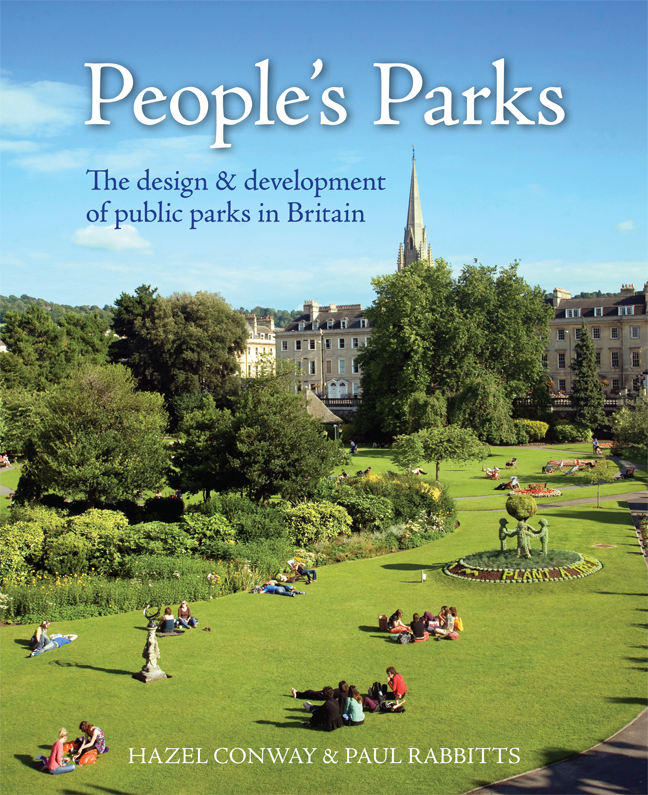Book contents
- Frontmatter
- Dedication
- Contents
- Miscellaneous Frontmatter
- Preface
- Acknowledgements
- Foreword
- A Word from Parks Professionals, Politicians and Parks Organisations
- Introduction: Dr Hazel Conway (1991)
- 1 Public Parks and Municipal Parks
- 2 The Need for Parks
- 3 Pioneering Parks Development
- 4 The Park Movement
- 5 Design and Designers
- 6 Lodges, Bandstands and the Cultivation of Virtue
- 7 Local Pride and Patriotism
- 8 Planting and Park Maintenance
- 9 Permitted Pastimes
- 10 Recreation Grounds, Parks and the Urban Environment
- 11 Public Parks, 1885–1914
- 12 Later Municipal Park Designers
- 13 Garden Cities and the New Towns Movement
- 14 Sport, Physical Activity and Recreation in Public Parks in the Inter-war Years
- 15 Parks Management – a Changing Perspective
- 16 Decline, Revival and Renewal – the Role of Parks into 21st-century Britain
- Appendix 1 Summary of main legislation promoting early park development
- Appendix 2 Chronology of main municipal and public park developments between 1800 and 1885
- Notes
- Bibliography
- Subscription List
- Index
10 - Recreation Grounds, Parks and the Urban Environment
Published online by Cambridge University Press: 22 February 2024
- Frontmatter
- Dedication
- Contents
- Miscellaneous Frontmatter
- Preface
- Acknowledgements
- Foreword
- A Word from Parks Professionals, Politicians and Parks Organisations
- Introduction: Dr Hazel Conway (1991)
- 1 Public Parks and Municipal Parks
- 2 The Need for Parks
- 3 Pioneering Parks Development
- 4 The Park Movement
- 5 Design and Designers
- 6 Lodges, Bandstands and the Cultivation of Virtue
- 7 Local Pride and Patriotism
- 8 Planting and Park Maintenance
- 9 Permitted Pastimes
- 10 Recreation Grounds, Parks and the Urban Environment
- 11 Public Parks, 1885–1914
- 12 Later Municipal Park Designers
- 13 Garden Cities and the New Towns Movement
- 14 Sport, Physical Activity and Recreation in Public Parks in the Inter-war Years
- 15 Parks Management – a Changing Perspective
- 16 Decline, Revival and Renewal – the Role of Parks into 21st-century Britain
- Appendix 1 Summary of main legislation promoting early park development
- Appendix 2 Chronology of main municipal and public park developments between 1800 and 1885
- Notes
- Bibliography
- Subscription List
- Index
Summary
In 1878, when the opportunity of acquiring a 7-hectare site for a park occurred in Liverpool, there was fierce discussion on the merits of the proposal. The Liverpool Argus was adamant that ‘we do not want ornamental waters and dirty swans. We want open spaces where our little ragamuffins can exercise their limbs and fashion themselves into healthy Englishmen.’ Most of the major urban centres had, by the end of the 1870s, acquired parks, but if the area of open space was compared with the population figures, the achievement seemed less significant. Birmingham had a chain of seven parks on its outskirts, Liverpool had its ring of five parks, Manchester had three parks, but in terms of hectares of open space per head of population, Bradford with its five large parks ‘is our model city’. Bradford had ‘one acre of open space for every 755 of its inhabitants’, whereas in Liverpool the figure was ‘one acre per 1,011 people, in Birmingham it was 1,665, in Sheffield 3,665 and Wolverhampton had no open space at all’. A comparison with American parks seemed to indicate that achievement there was more substantial. Philadelphia's Fairmont Park was 7 miles long, and Central Park, New York, was larger than both Regent's Park and Hyde Park together.
The open spaces movements of the last quarter of the 19th century had two main aims: the creation of open space in densely populated districts, and the preservation of the countryside. Although geographically distinct, these targets were interlinked by the organisations and the individuals involved in them. These additional pressures for open space occurred at that time when the park movement itself had received enormous impetus from the passing of the Public Health Act 1875 and the question of accessibility was beginning to be confronted. From virtually the beginning of the park movement it had been recognised that the most densely populated districts had most need of open space for recreation, but large parks alone could not fulfil that need. Victoria Park in London had only been in use for a couple of years when, in 1847, The Builder criticised it for not being near enough to meet the needs of the poor.
- Type
- Chapter
- Information
- People's ParksThe design & development of public parks in Britain, pp. 169 - 180Publisher: Boydell & BrewerPrint publication year: 2023

